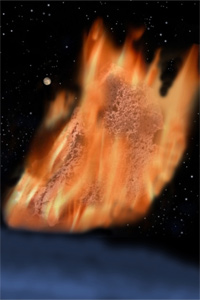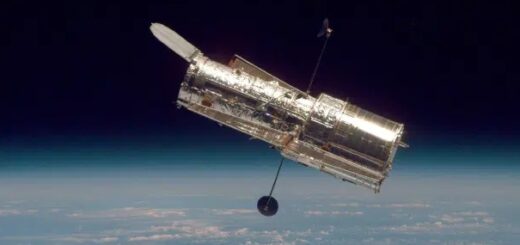Are we all Martians?

In summer 2011, a few Moroccan night owls saw Martians in the Sahara Desert. The otherworldly visitors didn’t arrive in a flying saucer, but on a 2.4-pound (1.1-kilogram) fragment of rock that glowed red-hot in Earth’s atmosphere before landing near the village of Tissint.
OK, we’re taking a few liberties with the story. The rock — a meteorite — did indeed come to our planet from Mars. Whether we can slap a “Life On Board” sign to its black, dimpled surface remains to be seen. Other Martian meteorites, however, have provided clues about a truly tantalizing possibility: that primitive bacteria first formed on our red neighbor and then traveled through space to Earth, where they became the seeds of our spectacular biological diversity. If that idea were proved true, we’d all be Martians rather than Earthlings.
It’s not a new proposal. In the 19th century, British physicist William Thomson Kelvin, known to most students as the father of the absolute temperature scale (measured in kelvins), also had a few ideas about geologic history and the evolution of life on Earth. One was that seed-bearing meteorites zipped through outer space.
“If at the present instant no life existed upon this earth, one such stone falling upon it might … lead to its becoming covered with vegetation,” Kelvin said while addressing the British Association for the Advancement of Science in 1871.
Swedish chemist and Nobel laureate Svante Arrhenius pursued a similar concept in “Worlds in the Making,” which was published in 1906. In the book, Arrhenius introduced the term panspermia to describe a process by which bacterial spores could drift through the solar system on undulating currents of electromagnetic energy.
For a while, these notions seemed like the musings of hardcore scientists turned a little batty. Then, in the 20th century, evidence for panspermia became more abundant and more compelling. One of the real turning points came when NASA sent two Viking probes to Mars in 1975. The Viking 1 lander touched down in Chryse Planitia, Viking 2 in Utopia Planitia. Both snapped photos of the Martian landscape and then measured various properties of the atmosphere and soil. The Viking data didn’t conclusively prove the existence of life on Mars, but it did reveal the red planet had a unique ratio of noble gas isotopes in its atmosphere.
In the 1980s, scientists discovered a similar chemical signature in a group of space rocks known as the SNC meteorites (named after three representative members of the group: Shergotty, Nakhla, Chassigny). The gases found trapped in these meteorites matched the gases detected by the Viking landers when they tested the Martian atmosphere in the 1970s.
They also study previously collected specimens to see if any should be reclassified. Of the 53,000 meteorites that we’ve officially cataloged on Earth, 104 have been labeled Martian [source: Marlow]. Eyewitnesses have only seen five of these rare rocks arrive on our planet. The rest made a quiet entry and were found after their impact, often in Antarctica or North Africa because they’re easy to spot on ice or sand.
Signs of Life
Over time, astronomers were able to identify more of these so-called Martian meteorites. And they began to seriously scrutinize them. In 1996, a team of NASA scientists shocked the world when they reported that they had found fossils of Martian bacteria in a meteorite known as ALH84001.
The ALH84001 meteorite, which was unearthed in the Allan Hills area of Antarctica in 1984, contained yellowish grains of carbonate, a common mineral that can have biologic origins. When the scientists studied the carbonate under an electron microscope, they saw rodlike structures that they said were fossilized bacteria cells. They also detected iron sulfides and magnetite, two compounds synthesized simultaneously by certain bacteria. The research team hypothesized that the bacteria formed on Mars and traveled to Earth as passengers aboard ALH84001.
Since then, several studies have shown that the chemical compounds in ALH84001 likely formed without the influence of any life processes and therefore don’t prove the existence of Martian life. But the question has never been conclusively answered one way or the other. As a result, interest in Martian meteorites remains high, and scientists and rock hounds scour the globe to find new specimens.
They also study previously collected specimens to see if any should be reclassified. Of the 53,000 meteorites that we’ve officially cataloged on Earth, 104 have been labeled Martian [source: Marlow]. Eyewitnesses have only seen five of these rare rocks arrive on our planet. The rest made a quiet entry and were found after their impact, often in Antarctica or North Africa because they’re easy to spot on ice or sand.



 Creators of mankind
Creators of mankind Description of “Tall white aliens”
Description of “Tall white aliens” Where they came from?
Where they came from? About hostile civilizations
About hostile civilizations The war for the Earth
The war for the Earth “Tall white aliens” about eternal life
“Tall white aliens” about eternal life Video: “Nordic aliens”
Video: “Nordic aliens” Aliens
Aliens Alien encounters
Alien encounters The aliens base
The aliens base UFO
UFO Technology UFO
Technology UFO Underground civilization
Underground civilization Ancient alien artifacts
Ancient alien artifacts Military and UFO
Military and UFO Mysteries and hypotheses
Mysteries and hypotheses Scientific facts
Scientific facts


















